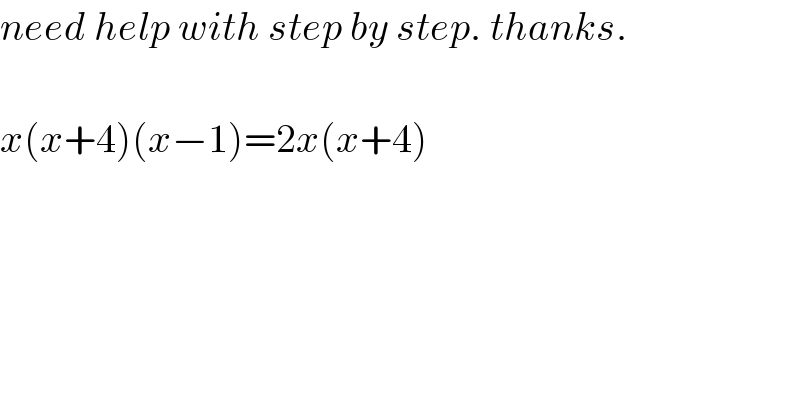
Question and Answers Forum
Question Number 7234 by WagST last updated on 17/Aug/16

Answered by Yozzia last updated on 17/Aug/16
![x(x+4)(x−1)=2x(x+4) (∗) Adding −2x(x+4) on both sides of (∗) gives x(x+4)(x−1)−2x(x+4)=2x(x+4)−2x(x+4) ∵ 2x(x+4)−2x(x+4)=0 ∴ x(x+4)(x−1)−2x(x+4)=0 By the distributive law a(b+c)=ab+bc ⇒ x(x+4)[(x−1)−2]=0 ⇒ x(x+4)[x−3]=0 Now, in general, a product a×b×c×...×z=0 iff at least one of a,b,c,...,z is zero. Hence for x(x+4)(x−3)=0 at least one of x, (x+4) or (x−3) is zero. ∴ x=0 or x=−4 or x=3.](Q7235.png)
| ||
Question and Answers Forum | ||
Question Number 7234 by WagST last updated on 17/Aug/16 | ||
 | ||
Answered by Yozzia last updated on 17/Aug/16 | ||
![x(x+4)(x−1)=2x(x+4) (∗) Adding −2x(x+4) on both sides of (∗) gives x(x+4)(x−1)−2x(x+4)=2x(x+4)−2x(x+4) ∵ 2x(x+4)−2x(x+4)=0 ∴ x(x+4)(x−1)−2x(x+4)=0 By the distributive law a(b+c)=ab+bc ⇒ x(x+4)[(x−1)−2]=0 ⇒ x(x+4)[x−3]=0 Now, in general, a product a×b×c×...×z=0 iff at least one of a,b,c,...,z is zero. Hence for x(x+4)(x−3)=0 at least one of x, (x+4) or (x−3) is zero. ∴ x=0 or x=−4 or x=3.](Q7235.png) | ||
| ||